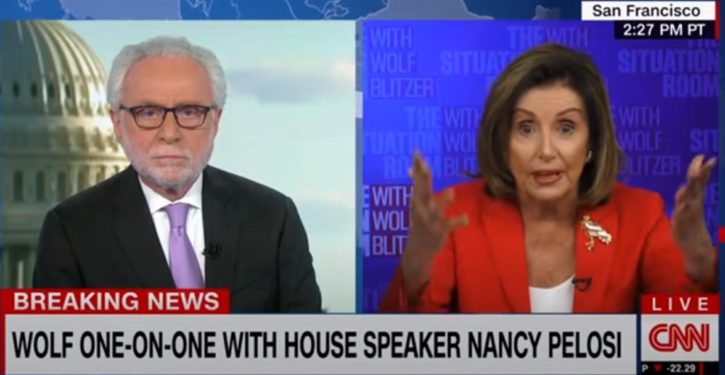
Liberty Unyielding has been following this since it became apparent with news reporting on Monday. In retrospect, it seems to have started with a podcast appearance on Friday (9 October) by a World Health Organization official, Dr. David Nabarro.
Dr. Nabarro is the WHO Special Envoy for COVID-19, and in the podcast interview with the (UK) Spectator, he urged world leaders to “stop using lockdown as your primary control measure.”
WATCH: Dr David Nabarro, the WHO's Special Envoy on Covid-19, tells Andrew Neil: 'We really do appeal to all world leaders: stop using lockdown as your primary control method'. Watch the full interview here: https://t.co/XLdaedsKVS #SpectatorTV @afneil | @davidnabarro pic.twitter.com/1M4xf3VnXQ
— The Spectator (@spectator) October 9, 2020
Will this presidential election be the most important in American history?
Since the WHO had advocated lockdowns early on, this looked like a flip-flop by the organization. It would frankly be a very big one.
It’s not just the WHO that seems to be doing an about-face on one of the most significant aspects of the coronavirus pandemic response. On Monday, the New York Times – never a fan of the Trump administration – published a remarkably cheerful report on the pandemic, one that flies in the face of themes routinely flogged by U.S. Democrats and the mainstream media, including the New York Times.
A Daily Wire summary pulled out salient points from the NYT article, opening with this eye-opener:
A new report from The New York Times indicates that experts have “genuine confidence” that the coronavirus pandemic will end “far sooner” than originally expected and that President Donald Trump’s Operation Warp Speed — the administration’s efforts to facilitate and accelerate the development, manufacturing, and distribution of vaccines, therapeutics, and diagnostics — has been “working with remarkable efficiency.”
Eh? Suddenly the Trump administration has been doing something right?
Many Americans became aware of the NYT report because Rush Limbaugh took it up in his radio broadcast on Tuesday.
“We really gotta dig into this,” he said, with understandable skepticism.
“Now, something is behind this, folks. Something is behind this,” Limbaugh continued. “I think part of it is that there must be polling because everything in major political party politics, especially the Democrats, is done bouncing off of or reacting to polling.”
Limbaugh suggests people’s weariness with the lockdowns is likely to harm Joe Biden, which one can hardly disagree with. Perhaps, as he says, “the New York Times and the World Health Organization, which means the global left, is trying to take these issues off the table one way or another.” He does go through wondering why the “global left” wouldn’t try to ratchet up the fear factor instead. Limbaugh comes back to polling data on that, assuming “they” (Democrats, media) must have some data telling them it’s a non-starter.
But he concludes: “I still haven’t been able to synthesize this down to its simplest form.” Rush Limbaugh is still looking for an answer that makes sense to him.
At the same time as this very sudden vector shift on COVID-19, there has been a strange parade of rogue media developments. LU writers have captured some of them for us: on Monday Ben Bowles covered Jake Tapper and Wolf Blitzer lighting into top Democrats (Biden’s deputy campaign director, Kate Bedingfield, and Senator Richard Blumenthal) who were arguing that it’s “unconstitutional” of Trump and the Republican Senate to have a Supreme Court nomination process just before the election.
In an LU Staff article later on Monday, we noted that ABC’s Jonathan Karl wouldn’t let Biden’s campaign co-chair, Rep. Cedric Richmond (D-LA), get away with claiming that there’s no plan to raise taxes on the middle class.
These instances of forceful pushback against Democratic whoppers have not been at all characteristic of the mainstream media news hosts in the last decade.
Meanwhile, something odd is going on at the New York Times. The sudden enthusiasm for the Trump administration’s pandemic performance, evinced in the article on COVID-19 progress, was one instance. Another was NYT editorialist Bret Stephens coming out with a stinging criticism of the paper’s flagship “1619 Project,” published on 10 October.
Most tellingly, Stephens spoke in a few sentences of the best principles of journalism, and then laid down this marker: “[O]n these points — and for all of its virtues, buzz, spinoffs and a Pulitzer Prize — the 1619 Project has failed.”
That’ll wake ’em up at a journalistic enterprise. Stephens didn’t just account the project a failure; he named people in the organization who were defending it, rather lamely, against his fully documented criticisms. Those individuals did not come off well in the telling. On Twitter, the buzz was that Stephens had just written his professional suicide note.
But then on Sunday, NYT’s fresh-caught media editor, Ben Smith (formerly of BuzzFeed, the editor who decided to publish the Steele dossier in January 2017), published a lengthy article about the increasingly dubious terrorism reporting of Rukmini Callimachi, the NYT reporter who has covered, among other sensational stories, the self-proclaimed “ISIS terrorist” Abu Hufayzah.
Abu Hufayzah turned out recently to be a Canadian named Shehroze Chaudry, whose accounts of his derring-do with ISIS appear to the Canadian authorities to be almost certainly fake. He is being investigated under Canadian hoax laws, in fact (and it’s not even clear that he was ever in Syria, where he claims to have participated in gruesome activities with the bloodthirsty terrorists).
But not only had Ms. Callimachi reported at length on “Abu Hufayzah”; NYT had built a much-touted podcast around her reporting, and with the hook of the Abu Hufayzah story line. That’s a big investment.
Smith, like Stephens, did a takedown of Callimachi’s work in his 11 October piece. And, like Stephens, he named names, identifying the people at the paper – his own organization, from which he draws a paycheck – who disputed his characterizations.
In the more typical course of things, we’d expect to see the New York Times make a top-level decision about casting such doubt on a high-profile reporter like Callimachi, and then present the whole conclusion as an approved package, in which there was an organizational statement about the reporting, and no trace of internal dissent, especially not with people’s names attached to it.
None of that is to be found in Ben Smith’s article.
It’s hard not to catch a whiff, from the outside, of a meltdown going on at the NYT. Put these two examples together with the sudden support for the Trump administration on COVID policy, and it’s as if Jim Carrey has shown up with fairy-tale powers, and is forcing newsreader Steve Carell to gibber, wriggle, and speak in tongues.
https://www.youtube.com/watch?v=cmlq40G9xK8
There are probably more examples out there. This seems to be a fast-emerging trend. But another, very arresting instance of media discomfiture for Democrats occurred on Tuesday in an interview Wolf Blitzer did with Nancy Pelosi at CNN. In the interview (video below), Blitzer was astonishingly persistent with Pelosi on the topic of why she refused to take up President Trump’s coronavirus relief bill and extend benefits to people suffering economically from the lockdowns.
Becket Adams put it this way at the Washington Examiner: “The cable host spent the remainder of their nearly 20-minute-long conversation asking again and again why Pelosi cannot simply accept the White House’s deal, even when members of her own caucuses seem eager to pass it. Pelosi did not respond kindly.”
For just a flavor of Pelosi’s intense annoyance at being challenged, consider this riposte to Blitzer: “What makes me amused, if it weren’t so sad, is how you all think that you know more about the suffering of the American people than those of us who are elected by them to represent them at that table.”*
https://www.youtube.com/watch?v=VFIVdWM5lL4&feature=emb_logo
https://www.youtube.com/watch?v=52ny-XA2w0c&feature=emb_logo
There’s a lot – a whole lot – from Pelosi about the lack of respect she’s getting from Blitzer’s line of questioning. It’s the only word she seems to know. She clearly doesn’t appreciate being treated like, you know, a Republican.
But Blitzer doesn’t back off. In the context of a decade or more of predictably sycophantic media coverage for Democrats, this is gobsmacking. Something is going on.
If we saw only one of these patterns emerging, it would be easier to suggest what that something is. The meltdown at NYT is the hardest to account for. The about-face on COVID coverage – suddenly it could all be over really soon – sounds like it has some separate premise behind it, presumably related to whatever’s going on with the WHO. But what is causing NYT to just as suddenly start burbling out little random truth bombs with no apparent editorial governor on them?
The COVID vector shift, on its own, seems like something being coordinated somewhere. Those are some really big muscle movements – saying lockdowns should end, predicting a quick resolution of the whole pandemic problem – to be mere twitches.
One thing is for sure: if institutional thinking on the coronavirus pandemic has really turned on a dime like this, we are fully justified in asking how much of what we’ve been put through this year was ever for a genuine, honest purpose. “Oops, folks, our bad” is not an honest signal about policy mandates that have put billions of people at risk from sinking economies.
The equally sudden astringent quality of media personalities with top Democrats this week also looks coordinated. If we were seeing only that pattern, I would have to ask if there was a rolling takedown of senior Democrats starting up. Those senior Democrats have been heavily dependent for a long time on absurdly accommodating media coverage. They’ve lost the ability to function without it. Cause it to turn on them, and they can be humiliated, marginalized, exposed as largely impotent without it.
It’s not anyone on the Republican side, however, who has the power to cause that effect, even if Republicans wanted to. If the media are turning against the most senior of the legacy, Old Consensus Democrats, they’re doing it at the behest of the new, more radical Democrats, and more specifically, the dark-money backers of the party’s radical element.
In my judgment, it’s too early to draw conclusions about that. The fact that we’ve seen all these patterns emerge at exactly the same time suggests that they are related. We can postulate a political link between the apparent shift in COVID messaging and the sudden prickliness of MSM outlets this week with Democrats.
But the New York Times going full Steve-Carell-in-Bruce-Almighty doesn’t really fit any comprehensive theory of the developments. It doesn’t help us answer the key questions cui bono (who benefits)? and cuius finis (whose goal)? It just looks like an internal street fight at the NYT, detected from outside the walls by a few “fwap!” and “kapow!” cartoon noises.
Except for that weird endorsement of the Trump administration’s coronavirus policies. That one’s a poser. More to follow on this, no doubt.
* Note: the Washington Examiner article suggests that in her peevish reactions to Blitzer, Pelosi is behaving like Trump. But this misses the mark about Trump’s attitude and behavior. He actually never whines about whether he’s being respected or not. He doesn’t cry-bully in that passive-aggressive way; he goes on offense. I would never defend a number of the brutal things he has said to attack some of his critics, but those who think they hear whining from him are not listening with their ears, but with their own sense of annoyance at his affect.
Nancy Pelosi is trying to guilt Blitzer back into line in this interview. Trump never uses passive-aggressive button-pushing that way in someone else’s conversation. He opens up with annihilating verbal mortar barrages, with the intent to make it his conversation: to change the whole proposition and dynamics of the exchange. He’s kind of a walking dialectic generator, with the twist that he’s always originating a new thesis, and it’s the other guy who’s scrambling for an antithesis with some teeth, to regain some momentum.




